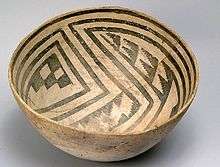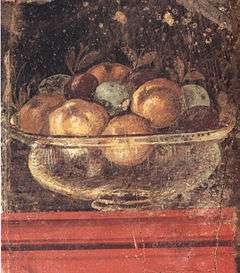Bowl
.jpg)
A bowl is a spherical dish or container typically used to serve hot and cold food, or in food preparation, in many cultures . Bowls are normally round but can be any shape including square or rectangular. Bowls used for storing non-food items range from small bowls used for holding tips at a coffee shop to large bowls used for storing DVDs or CDs.
Bowls may be are typically small and shallow, as in the case of bowls used for single servings of soup or cereal. Some bowls, such as punch bowls, serving bowls, fruit bowls and salad serving bowls, are larger and often intended to serve many people. At the extremes of the shape there is some overlap with cups, for example in tea bowls and with plates or dishes with raised extremities, such as soup plates. "Cup" is typically used for drinking vessels taken to the mouth, but this includes many shapes that would otherwise be called "bowls", or are.
The British/American standard soup bowl has a mouth, the opening not including the extent of its lip, with a diameter of 18.5 centimetres, and should be able to adequately accommodate at least 24 ounces of liquid.
Modern bowls can be made of ceramic, metal, wood, plastic, and other materials. Bowls have been made for thousands of years. Very early bowls have been found in China, Ancient Greece, Crete and in certain Native American cultures.

In Ancient Greek pottery, small bowls, including phiales and pateras, and bowl-shaped cups called kylices were used. Phiales were used for libations and included a small dent in the center for the bowl to be held with a finger, although one source indicates that these were used to hold perfume rather than wine. Some Mediterranean examples from the Bronze Age manifest elaborate decoration and sophistication of design. For example, the bridge spouted vessel design appeared in Minoan at Phaistos.[1] In the 4th century BC, evidence exists that the Uruk culture of ancient Mesopotamia mass-produced beveled rim bowls of standardized sizes. Moreover, in Chinese pottery, there are many elaborately painted bowls and other vessels dating to the Neolithic period. As of 2009, the oldest found is 18,000 years old.[2]
In examining bowls found during an archaeological dig in North America, the anthropologist Vincas Steponaitis defines a bowl by its dimensions, writing that a bowl's diameter rarely falls under half its height and that historic bowls can be classified by their edge, or lip, and shape.
A bowl is also a standard unit of measure, as defined by the American Institute of Measurements (AIM). One bowl is the equivalent of 3.75 cups or 887.2059 ml.
Gallery
 Transparent glass bowl of fruit. Wall painting in the Roman Villa Boscoreale, Italy (1st century AD)
Transparent glass bowl of fruit. Wall painting in the Roman Villa Boscoreale, Italy (1st century AD)- Qing era Chinese porcelain cup or bowl
- A set of wooden bowls found on board the 16th century ship Mary Rose
- Slender-waisted bowl (a Vietnamese type of bowl)
 Unfinished ancient Egyptian stone bowl showing how its middle was hollowed. Soft limestone. From a waste around the pyramid at Lahun, Fayum, Egypt. Ptolemaic period.
Unfinished ancient Egyptian stone bowl showing how its middle was hollowed. Soft limestone. From a waste around the pyramid at Lahun, Fayum, Egypt. Ptolemaic period.
See also
Notes
References
- C. Michael Hogan Phaistos fieldnotes, The Modern Antiquarian, 2007
- Vincas P. Steponaitis. 1983. Ceramics, Chronology, and Community Patterns: An Archaeological Study at Moundville, pp 68–69. New York: Academic Press. ISBN 0-12-666280-0. (Table of contents available online)
- H. B. Walters. 1905. History of Ancient Pottery: Greek, Etruscan, and Roman, pp 140,191–192. New York: Charles Scribner's Sons.
External links
- The Phiale of Achyris - On the website of the Archeological Institute of America. The Phiale is dated from 300 BC and is made of gold, includes pictures.
- Corning Museum of Glass